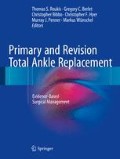Abstract
Infections following total ankle replacement are a serious complication, about which there is little information in the current literature to guide diagnosis and treatment. Infections are classified as acute postoperative, late chronic, or remote hematogenous. Prosthesis removal for infection following primary or revision total ankle replacement along with a thorough debridement and parenteral culture-driven antibiotic therapy are the mainstay of treatment. Only a limited number of patients who develop a deep periprosthetic infection following primary or revision total ankle replacement can expect to undergo successful joint-preserving revision total ankle replacement. Instead, ankle or tibio-talo-calcaneal arthrodesis usually with significant volumes of bone graft is required to obtain a functional limb. Given the morbidity of infected total ankle replacement, careful consideration should be made about performing these procedures in patients with multiple prior surgeries and comorbidities that predispose to wound healing difficulties. Prompt diagnosis and involvement of a multidisciplinary care team is essential to a successful outcome.
Access this chapter
Tax calculation will be finalised at checkout
Purchases are for personal use only
References
Glazebrook MA, Arsenault K, Dunbar M. Evidence-based classification of complications in total ankle arthroplasty. Foot Ankle Int. 2009;30(10):945–9.
Spirit AA, Assal M, Hansen Jr ST. Complications and failure after total ankle arthroplasty. J Bone Joint Surg Am. 2004;86(6):1172–78.
Saltzman C, Mann RA, Ahrens JE, Amendola A, Anderson RB, Berlet GC, et al. Prospective controlled trial of STAR total ankle replacement versus ankle fusion: initial results. Foot Ankle Int. 2009;30(7):579–96.
Besse JL, Colombier JA, Asencio J, Bonnin M, Gaudot F, Jarde O, et al. Total ankle arthroplasty in France. Orthop Traumatol Surg Res. 2010;96(3):291–303.
Uçkay I, Lübbeke A, Huttner B. Preoperative asymptomatic bacteriuria and subsequent joint infection: lack of causal relation. Clin Infect Dis. 2014;59(10):1506–07.
Bouvet C, Lübbeke A, Bandi C, Pagani L, Stern R, Hoffmeyer P, et al. Is there any benefit in preoperative urinary analysis before elective total joint replacement? Bone Joint J. 2014;96(3):390–94.
Ipe DS, Sundac L, Benjamin Jr WH, Moore KH, Ulett GC. Asymptomatic bacteriuria: prevalence rates of causal microorganisms, etiology of infection in different patient populations, and recent advances in molecular detection. FEMS Microbiol Lett. 2013;346(1):1–10.
Zhanel GG, Harding GK, Guay DR. Asymptomatic bacteriuria. Which patients should be treated? Arch Intern Med. 1990;150(7):1389–96.
David TS, Vrahas MS. Perioperative lower urinary tract infections and deep sepsis in patients undergoing total joint arthroplasty. J Am Acad Orthop Surg. 2000;8(10):66–74.
Bohn WW, McKinsey DS, Dykstra M, Koppe S. The effect of a portable HEPA-filtered body exhaust system on airborne microbial contamination in a conventional operating room. Infect Control Hosp Epidemiol. 1996;17(7):419–22.
Evans RP. Current concepts for clean air and total joint arthroplasty: laminar airflow and ultraviolet radiation: a systematic review. Clin Orthop Relat Res. 2011;469(4):945–53.
Panahi P, Stroh M, Casper DS, Parvizi J, Austin MS. Operating room traffic is a major concern during total joint arthroplasty. Clin Orthop Relat Res. 2012;470(10):2690–4.
Bibbo C, Goldberg JW. Infectious and healing complications after elective orthopaedic foot and ankle surgery during tumor necrosis factor-alpha inhibition therapy. Foot Ankle Int. 2004;25(5):331–5.
Bibbo C, Patel DV, Gehrmann RM, Lin SS. Chlorhexidine provides superior skin decontamination in foot and ankle surgery: a prospective randomized study. Clin Orthop Relat Res. 2005;438:204–8.
Keblish DJ, Zurakowski D, Wilson MG, Chiodo CP. Preoperative skin preparation of the foot and ankle: alcohol and bristles are better. J Bone Joint Surg Am. 2005;87(5):986–92.
Bibbo C. Treatment of the infected extended ankle arthrodesis after tibio-talo-calcaneal retrograde nailing. Tech Foot Ankle Surg. 2002;1:74–96.
Love C, Marwin SE, Palestro CJ. Nuclear medicine and the infected joint replacement. Semin Nucl Med. 2009;39(1):66–78.
Teller RE, Christie MJ, Martin W, Nance EP, Haas DW. Sequential indium-labeled leukocyte and bone scans to diagnose prosthetic joint infection. Clin Orthop Relat Res. 2000;373:241–7.
Joseph TN, Chen AL, Di Cesare PE. Use of antibiotic-impregnated cement in total joint arthroplasty. J Am Acad Orthop Surg. 2003;11(1):38–47.
Scorzolini L, Lichtner M, Iannetta M, Mengoni F, Russo G, Panni AS, et al. Sonication technique improves microbiological diagnosis in patients treated with antibiotics before surgery for prosthetic joint infections. New Microbiol. 2014;37(3):321–8.
Bibbo C, Barbieri RA, Deitch EA, Brolin RE. Neutropenic enterocolitis in a trauma patient during antibiotic therapy for osteomyelitis. J Trauma. 2000;49(4):760–3.
Bibbo C. Temporary cementation in total ankle arthroplasty. J Foot Ankle Surg. 2013;52(5):650–4.
Bibbo C, Anderson RB, Davis WH. Limb salvage: the infected retrograde tibio-talo-calcaneal nail. Foot Ankle Int. 2003;24(5):420–5.
Bibbo C. Revision ankle arthrodesis, chapter 20. In: Alexander IJ, Bluman EM, Greisberg JK, editors. Advanced reconstruction: foot and ankle 2. Chicago: American Academy of Orthopaedic Surgeons; 2015.
Author information
Authors and Affiliations
Corresponding author
Editor information
Editors and Affiliations
Rights and permissions
Copyright information
© 2016 Springer International Publishing Switzerland
About this chapter
Cite this chapter
Bibbo, C., Kovach, S.J. (2016). Management of the Infected Total Ankle Replacement. In: Roukis, T., et al. Primary and Revision Total Ankle Replacement. Springer, Cham. https://doi.org/10.1007/978-3-319-24415-0_25
Download citation
DOI: https://doi.org/10.1007/978-3-319-24415-0_25
Published:
Publisher Name: Springer, Cham
Print ISBN: 978-3-319-24413-6
Online ISBN: 978-3-319-24415-0
eBook Packages: MedicineMedicine (R0)

